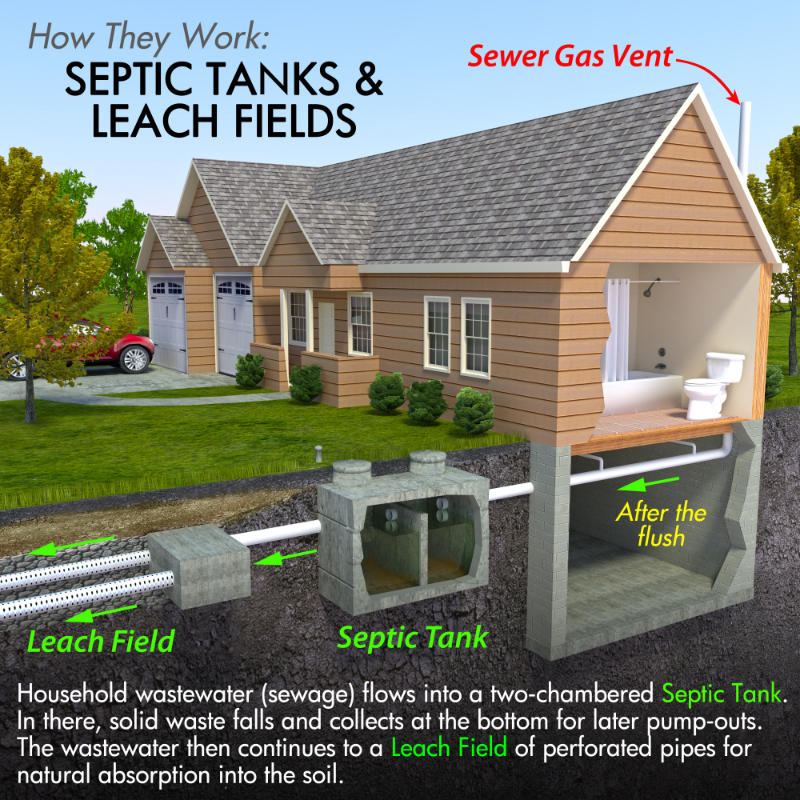 A properly installed and well-maintained septic system is an efficient and cost effective way to treat wastewater from a household where a sewage system is not available. A septic system also helps safeguard the quality of groundwater. At SewerMan we are experts at maintaining septic systems and will work with you on keeping your septic system in top working order.
A properly installed and well-maintained septic system is an efficient and cost effective way to treat wastewater from a household where a sewage system is not available. A septic system also helps safeguard the quality of groundwater. At SewerMan we are experts at maintaining septic systems and will work with you on keeping your septic system in top working order.
-

Sewer-Man was fast and dependable to clear my sewer line!
 Tracy
Tracy

For Septic System Maintenance in Alplaus, NY Call (518) 612-4200
How a Septic System Works
A septic system has several principal components; two of these are the septic tank and a leach or drain field.
Septic Tank
Wastewater and other effluents from washing machine, sinks and toilets flow to the septic tank. It is a concrete or fiberglass water tight container that is buried underground close to the house. Its size is dependent on the number of bathrooms in the house and the volume of water usage. Some septic tanks have two chambers while others have only one. Inside the septic tank the wastewater is divided into three parts; the heavy solids that settle at the bottom of the tank, the grease and fat called floatables that float up to the surface and the “clear” liquid waste that is in the middle. The buildup of solids that settle at the bottom of the tank is known as sludge and the floatables are called scum.
Inside the tank, the wastewater is given preliminary treatment by what is known as anaerobic digestion treatment where anaerobic bacteria that survive in an environment without oxygen break down and digest the sludge. This releases gas through the air vent and neutralizes some of the germs contained in the waste. The clear liquid effluent at the middle of the tank flows to the leach or drain field for further treatment.
Leach or Drain Field
A leach or drain field is a soil filter which consists of gravel trenches where perforated distribution pipes are buried over layers of soil and gravel. It is important that the soil where the leach or drain field is located is permeable and has the capacity to absorb water. City or county ordinances dictate the depth of the soil layer or its distance from the ground water level. Its size, layout and design are also defined by the city or county regulations or code and are usually dependent on the absorptive capability of the soil, the volume of wastewater generated and its distance from the ground water level.
The clear liquid waste from the septic tank flows to the leach or drain field either by gravity or when necessary, is pumped out from a second chamber of the septic tank to the leach or drain field. Pumping becomes necessary when the drain field is at a higher elevation than the septic tank. The drain field is the second layer of wastewater treatment in the septic system. The treatment process that occurs in a leach field is called aerobic digestion, where aerobic bacteria, those that exist with oxygen, treat the water that flows to the drain field. A layer of these bacteria known as a biomat forms on the soil and the sidewall and bottom of the distribution pipes. These aerobic bacteria treat the contaminants and pollutants contained in the wastewater that flows through it. Aerobic bacteria digest the organic microorganism, germs, viruses and nutrients such as phosphorus and nitrogen contained in the wastewater.
The soil bed of the leach or drain field should be should be composed of the appropriate type of soil that will hold the wastewater for a protracted time to enable the treatment to take place, while permeable enough to allow the wastewater to eventually seep through the ground.
It is important to maintain your septic system. This keeps it operating efficiently and significantly reduces the chance of backups and costly repairs. At SewerMan of Alplaus, NY we are experts at keeping your septic system in good working order. Call us today to schedule your routine maintenance or for emergency repairs.

